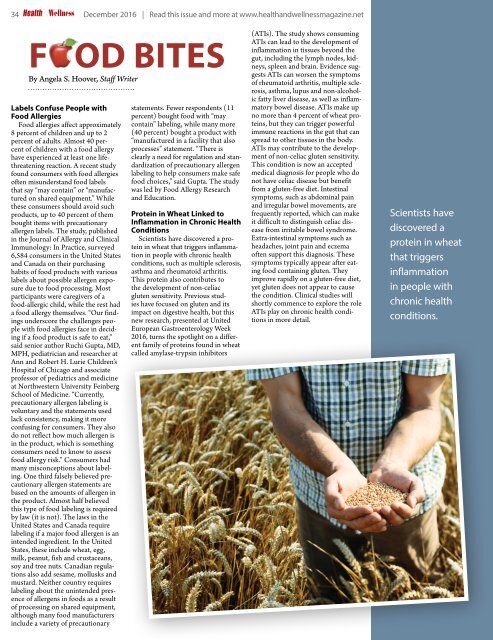Create successful ePaper yourself
Turn your PDF publications into a flip-book with our unique Google optimized e-Paper software.
34 & <strong>December</strong> <strong>2016</strong> | Read this issue and more at www.healthandwellnessmagazine.net | Like us @healthykentucky<br />
F OD BITES<br />
By Angela S. Hoover, Staff Writer<br />
Labels Confuse People with<br />
Food Allergies<br />
Food allergies affect approximately<br />
8 percent of children and up to 2<br />
percent of adults. Almost 40 percent<br />
of children with a food allergy<br />
have experienced at least one lifethreatening<br />
reaction. A recent study<br />
found consumers with food allergies<br />
often misunderstand food labels<br />
that say “may contain” or “manufactured<br />
on shared equipment.” While<br />
these consumers should avoid such<br />
products, up to 40 percent of them<br />
bought items with precautionary<br />
allergen labels. The study, published<br />
in the Journal of Allergy and Clinical<br />
Immunology: In Practice, surveyed<br />
6,584 consumers in the United States<br />
and Canada on their purchasing<br />
habits of food products with various<br />
labels about possible allergen exposure<br />
due to food processing. Most<br />
participants were caregivers of a<br />
food-allergic child, while the rest had<br />
a food allergy themselves. “Our findings<br />
underscore the challenges people<br />
with food allergies face in deciding<br />
if a food product is safe to eat,”<br />
said senior author Ruchi Gupta, MD,<br />
MPH, pediatrician and researcher at<br />
Ann and Robert H. Lurie Children’s<br />
Hospital of Chicago and associate<br />
professor of pediatrics and medicine<br />
at Northwestern University Feinberg<br />
School of Medicine. “Currently,<br />
precautionary allergen labeling is<br />
voluntary and the statements used<br />
lack consistency, making it more<br />
confusing for consumers. They also<br />
do not reflect how much allergen is<br />
in the product, which is something<br />
consumers need to know to assess<br />
food allergy risk.” Consumers had<br />
many misconceptions about labeling.<br />
One third falsely believed precautionary<br />
allergen statements are<br />
based on the amounts of allergen in<br />
the product. Almost half believed<br />
this type of food labeling is required<br />
by law (it is not). The laws in the<br />
United States and Canada require<br />
labeling if a major food allergen is an<br />
intended ingredient. In the United<br />
States, these include wheat, egg,<br />
milk, peanut, fish and crustaceans,<br />
soy and tree nuts. Canadian regulations<br />
also add sesame, mollusks and<br />
mustard. Neither country requires<br />
labeling about the unintended presence<br />
of allergens in foods as a result<br />
of processing on shared equipment,<br />
although many food manufacturers<br />
include a variety of precautionary<br />
statements. Fewer respondents (11<br />
percent) bought food with “may<br />
contain” labeling, while many more<br />
(40 percent) bought a product with<br />
“manufactured in a facility that also<br />
processes” statement. “There is<br />
clearly a need for regulation and standardization<br />
of precautionary allergen<br />
labeling to help consumers make safe<br />
food choices,” said Gupta. The study<br />
was led by Food Allergy Research<br />
and Education.<br />
Protein in Wheat Linked to<br />
Inflammation in Chronic <strong>Health</strong><br />
Conditions<br />
Scientists have discovered a protein<br />
in wheat that triggers inflammation<br />
in people with chronic health<br />
conditions, such as multiple sclerosis,<br />
asthma and rheumatoid arthritis.<br />
This protein also contributes to<br />
the development of non-celiac<br />
gluten sensitivity. Previous studies<br />
have focused on gluten and its<br />
impact on digestive health, but this<br />
new research, presented at United<br />
European Gastroenterology Week<br />
<strong>2016</strong>, turns the spotlight on a different<br />
family of proteins found in wheat<br />
called amylase-trypsin inhibitors<br />
(ATIs). The study shows consuming<br />
ATIs can lead to the development of<br />
inflammation in tissues beyond the<br />
gut, including the lymph nodes, kidneys,<br />
spleen and brain. Evidence suggests<br />
ATIs can worsen the symptoms<br />
of rheumatoid arthritis, multiple sclerosis,<br />
asthma, lupus and non-alcoholic<br />
fatty liver disease, as well as inflammatory<br />
bowel disease. ATIs make up<br />
no more than 4 percent of wheat proteins,<br />
but they can trigger powerful<br />
immune reactions in the gut that can<br />
spread to other tissues in the body.<br />
ATIs may contribute to the development<br />
of non-celiac gluten sensitivity.<br />
This condition is now an accepted<br />
medical diagnosis for people who do<br />
not have celiac disease but benefit<br />
from a gluten-free diet. Intestinal<br />
symptoms, such as abdominal pain<br />
and irregular bowel movements, are<br />
frequently reported, which can make<br />
it difficult to distinguish celiac disease<br />
from irritable bowel syndrome.<br />
Extra-intestinal symptoms such as<br />
headaches, joint pain and eczema<br />
often support this diagnosis. These<br />
symptoms typically appear after eating<br />
food containing gluten. They<br />
improve rapidly on a gluten-free diet,<br />
yet gluten does not appear to cause<br />
the condition. Clinical studies will<br />
shortly commence to explore the role<br />
ATIs play on chronic health conditions<br />
in more detail.<br />
Scientists have<br />
discovered a<br />
protein in wheat<br />
that triggers<br />
inflammation<br />
in people with<br />
chronic health<br />
conditions.
















